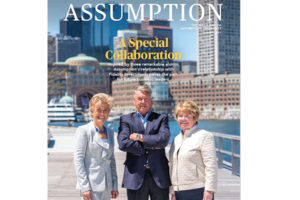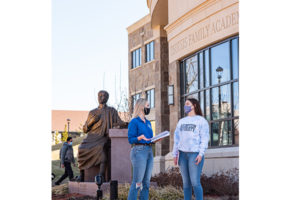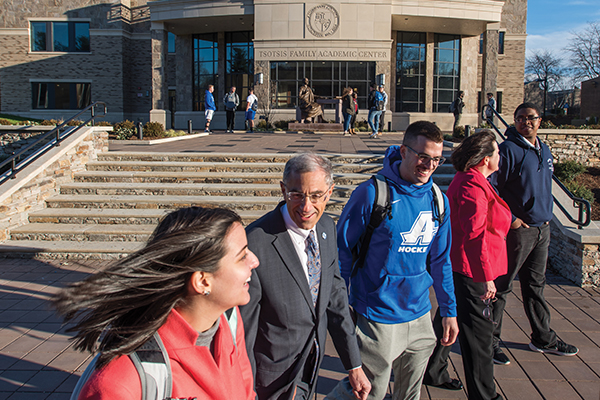
The new Tsotsis Family Academic Center is transforming how students learn at Assumption
By Holly Robinson
Stop by the new Tsotsis Family Academic Center “and you’ll feel energized,” promised English professor Jim Lang, Ph.D. “It’s wonderful to walk through the halls here and see the dynamic ways in which the faculty is teaching and students are learning.”
Named for Michael ʼ71 and Dot Tsotsis , the Center opened its doors this fall, offering an atrium and piazza, high-tech classrooms and seminar rooms, a performance hall with rehearsal room, and a ballroom for special events. The building serves as both a crossroads and hub for academic and arts disciplines, housing the Business Studies Department, the Honors Program, the Fortin and Gonthier Core Texts & Enduring Questions Program, a planned Center for the Study of Ethics, and the DʼAmour Center for Teaching Excellence (CTE), among others.
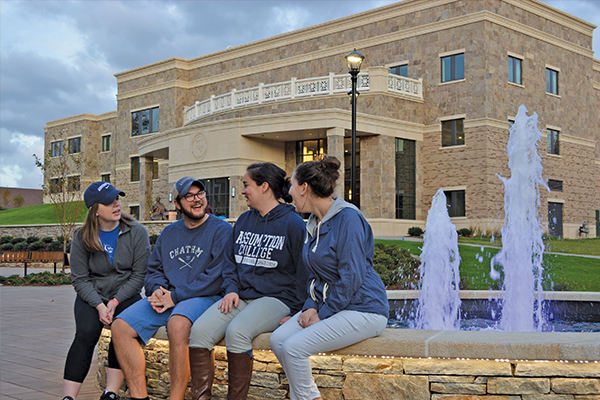
A Signature Building that Integrates the Liberal Arts with Professional Preparation
“This building was never about bricks and mortar,” said President Francesco C. Cesareo, Ph.D. From the statue of St. Augustine and the piazza outside the building to the state-of-the-art performance hall and high-tech classrooms it houses, “every aspect of this building, every detail, has meaning and significance inspired by a vision of education that aims at transforming the lives of our students,” he noted. “This building speaks to the centrality of the intellectual life of the campus and our mission as a Catholic liberal arts institution, one that seeks to integrate the classical liberal arts tradition with professional formation.”
For instance, Visiting Instructor of Management Libby OʼHara says the new classrooms give her the technology and flexible seating she needs to demonstrate to students how things get done in the “real” world. With LCD monitors along the walls in addition to a large monitor up front, professors can walk around the classroom and offer feedback to students working together on group projects, or display select items for discussion to the entire class.
“In the business world, you often work in a team environment where you’re expected to listen to others and share your ideas,” OʼHara said. “These new classrooms help us teach students how to collaborate, problem-solve, and communicate effectively.”
In her sports marketing class recently, students broke into small groups to develop business plans aimed at helping Wachusett Mountain attract more college-aged skiers. They used the classroom technology to research and share “real-time” information, like the regionʼs demographics and spending trends, just as they would do if they were working for a marketing firm.
“The challenge for every professor today is how to keep students actively engaged,” OʼHara said. “This is a really fun way to teach, engage, and learn.”

Reflecting the institution’s Core Values through Functional, Beautiful Learning Spaces
Having a dedicated space in the DʼAmour Center for Teaching Excellence “signals the vital importance Assumption places on teaching and learning,” said CTE Director Lang, whose goal is “to encourage all faculty members to be aware of the most current pedagogical research and teaching strategies.” To that end, the CTE offers a spectrum of resources to all Assumption faculty, including individual consultations, travel grants, and research funding.
In designing the 62,000-square-foot Center, Nault Architects collaborated with administrators, faculty, and board members to create spaces that would encourage creative thinking and collaboration across the disciplines. “I love walking into the Honors Suite every morning and finding students working together on calculus problems on the whiteboard, or in the study room reading or writing their senior theses,” said Associate Professor of Philosophy Molly Flynn, Ph.D., who directs the Honors Program.
Prof. Flynn, who participated in the planning process, ensured that the Honors students would not only have quiet individual study spaces, but a place for the coffeemaker and areas with comfortable furniture where they can socialize. “Itʼs a very functional space, but it’s beautiful, too,” she said, “with nice wood and rich, calming colors accented by natural light from the windows.”
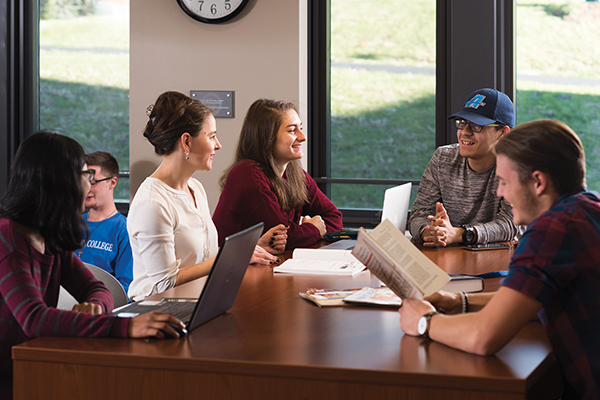
An Exciting Academic and Social Hub Where Students Ask the Big Questions
For Honors student Maeve McDonald ʼ21, the new space “really models what Assumption is trying to foster, which is a space where you can exercise your talents, but also work with other people.”
The new building’s design not only unifies people and departments at Assumption, but also reflects the institution’s core values, said Flynn. “We believe that studying the liberal arts is good for the soul. One of the things Assumption does best is to prepare students not only for a career, but for a thoughtful, meaningful life.”
Professor and Chair of Theology Marc Guerra, Ph.D., agreed. As director of the Fortin and Gonthier Core Texts & Enduring Questions Program, which offers an intense, integrated liberal arts education to students pursuing specialized natural science, mathematics, business, or humanities majors, he reminds students that most people will have five jobs and two careers over a lifetime, “but you’re always going to be yourself throughout your life. The most important question to ask is who you really want to be as a person.”
Guerra applauds the fact that the new Center integrates a variety of disciplines in a space that students use regularly. “The classrooms and seminar rooms are always packed, and because a host of professors have their offices in this building, itʼs easier for students to see their professors with greater regularity. This has become an exciting academic and social hub.”
Added OʼHara, “As a professor, my main goal is to continually challenge students and keep them actively engaged in learning. I want to hear students saying, ʻWow, that was an awesome classʼ whenever I teach them. This building has taken teaching and learning to a whole new level. Everyone has to step up their game a notch.”
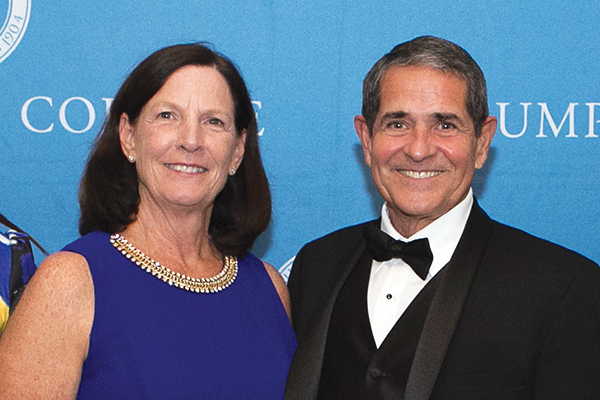
Michael ’71 and Dot Tsotsis Leave a Lasting Gift
When it came to naming Assumption’s new Academic Center, the decision was easy, given that former Trustee Michael Tsotsis ’71 and his wife Dot had donated the second-largest gift in the school’s history to make building the Center possible.
After graduating from Assumption, Tsotsis went on to found the Benefit Development Group, Inc. in 1976 and served as its chief executive officer and president. There, his client base included some of the largest companies in New England, yet he always found time to give back to his community. In addition to serving on Assumption’s Board of Trustees for 21 years, he served as chair/vice chair with the American Red Cross of Central Mass, Nativity School, and The United Way of Central Mass, as well as being active with other philanthropic organizations. In 2007, he was awarded the Kennedy Ambassador Award from Children’s Friends Inc.
“Assumption provided me with a firm foundation through which Dot and I raised a special family and built a successful business,” Tsotsis told reporters when his gift was announced. “As an Assumption graduate, I have tried to leave a positive impact on my alma mater, whether through volunteering or encouraging other alumni to also be supportive of Assumption.”
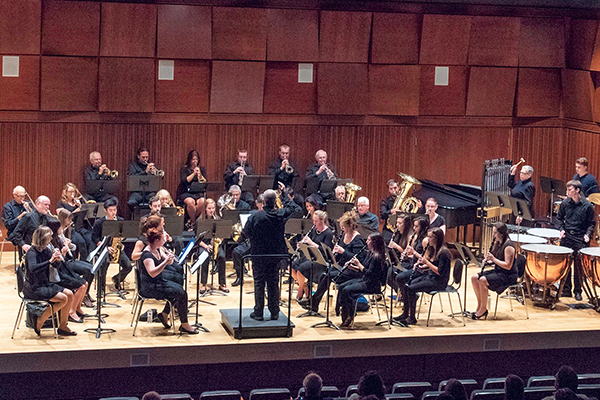
Turning a Grand Vision into a Working Reality
Every time Dan Lauring looks at the Tsotsis Family Academic Center, he feels proud. He should. His company, Lauring Construction, built it.
Although in many ways this project was “very typical” of the type of construction the family-run Lauring company usually takes on, one feature that stands out is the natural stone masonry, he said, noting that the stone “gives the building a strong and appealing look that highlights the Center’s importance.”
Architect Steve VanDyke of Nault Architects, the firm that designed the Center, said the choice of stone was a deliberate way to make the building stand out while honoring other buildings on campus. “The light palette of the stones complements the pale brick on the other buildings and gives the Center a strong connection to the chapel.”

